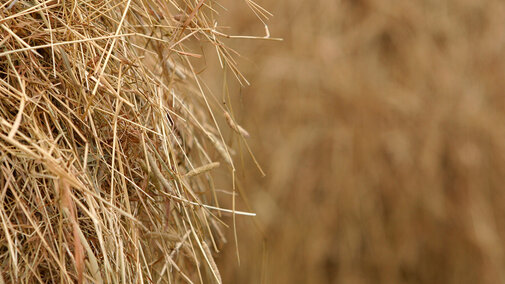Deciphering a Hay Test — Moisture
Having hay tested for nutrient quality is critical in getting the most out of the feedstuffs you have. Once the results come back, the next step is understanding the report you’ve received.
The first thing we notice on most feed or hay tests are the results are given in two different groups or columns. One is labeled along the lines of “as received” or “as fed” and another “dry basis.” Understanding the difference in these two columns is key to properly using the information provided when feeding your livestock.
“As received” represents the analysis of the sample as it was provided. This is what we will use to figure out rations or how much hay animals need to be provided. The “dry basis” is the sample after all moisture has been removed and doesn’t accurately represent the sample as it sits in the yard.
So why bother with “dry basis” if we don’t use it to figure feed amounts? Because when it comes to comparing feeds and finding the correct ratios in a ration, we need to compare things on an equal playing field.
For example, we could have a forage test on hay and silage come back as equal on a dry basis for energy, meaning that both feeds would provide the same amount of energy if dried out and fed. For the hay, this is pretty close to reality, but the silage contains much more water as is. Because of this, we would have to feed quite a bit more silage than hay to reach the same amount of energy in the ration, simply due to the extra weight from water.
“As received” and “dry basis” columns, may make a feed report look daunting, but understanding and using both is critical to getting the most out of your feed.
Using Bad Hay and Silage
Low supply and high costs mean some less-than-ideal feedstuffs may be used this winter. Low quality, mold and even mycotoxins can all be a risk for poor quality feeds. Can we still make use of these forage options?
Silage put up too wet has likely had a clostridial fermentation resulting in poor quality and high levels of butyric acid. Not only is feed quality reduced, but the stability of the pile once opened drops as well and mold growth on the feeding face is more likely.
In both hay and silage stored too dry, mold growth is a primary concern. Mold reduces feed quality and can limit intake in high quantities. In some circumstances, molds can produce mycotoxins, even with low mold counts. Impacts of mycotoxins are wide-ranging and depend on the specific toxin or toxins present and concentrations. Impacts can range from reduced intake to liver and rumen damage to infertility and abortions.
Whether too wet or too dry, these feed options are less than ideal but can still be used if we take precautions. First, test. Knowing the levels of mold, butyric acid or mycotoxin in a feed can help with the next step — dilution. Keeping poor feed to a low percentage of the overall diet can allow for use while minimizing risk to livestock. Finally, don’t feed to high-risk animals. Young calves, stressed animals and those in late gestation are all at higher risk of impact.
Low quality silage and hay comes with risks. Knowing the impact mold, mycotoxins and butyric acid can have on quality, intake and animal health is important and can help us plan the best way to use these imperfect feed resources.

